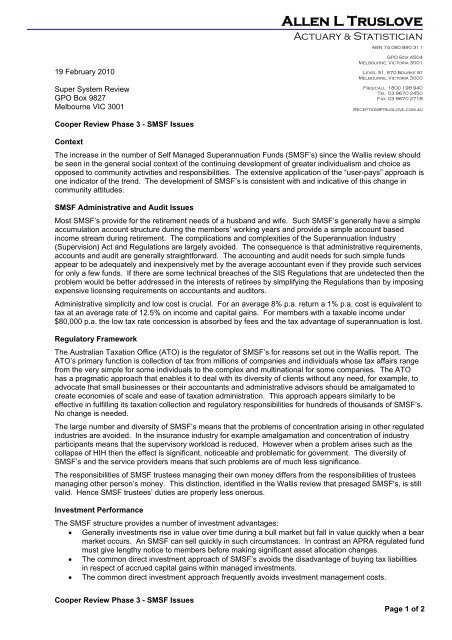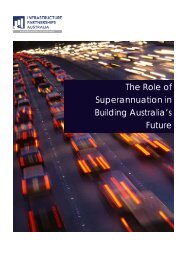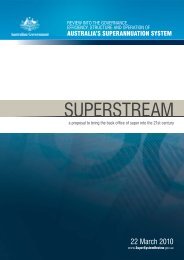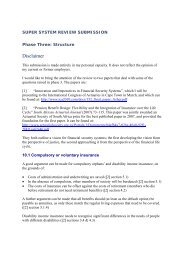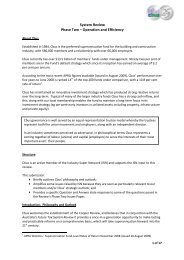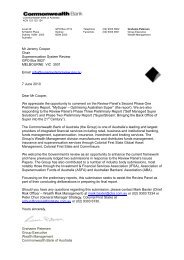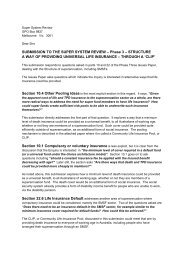Allen Truslove - Submission to the Super System Review
Allen Truslove - Submission to the Super System Review
Allen Truslove - Submission to the Super System Review
Create successful ePaper yourself
Turn your PDF publications into a flip-book with our unique Google optimized e-Paper software.
<strong>Allen</strong> L <strong>Truslove</strong><br />
Actuary & Statistician<br />
ABN 74 080 890 311<br />
19 February 2010<br />
<strong>Super</strong> <strong>System</strong> <strong>Review</strong><br />
GPO Box 9827<br />
Melbourne VIC 3001<br />
GPO Box 4504<br />
Melbourne, Vic<strong>to</strong>ria 3001<br />
Level 31, 570 Bourke St<br />
Melbourne, Vic<strong>to</strong>ria 3000<br />
Freecall 1800 198 940<br />
Tel 03 9670 2450<br />
Fax 03 9670 2718<br />
Reception@truslove.com.au<br />
Cooper <strong>Review</strong> Phase 3 - SMSF Issues<br />
Context<br />
The increase in <strong>the</strong> number of Self Managed <strong>Super</strong>annuation Funds (SMSF’s) since <strong>the</strong> Wallis review should<br />
be seen in <strong>the</strong> general social context of <strong>the</strong> continuing development of greater individualism and choice as<br />
opposed <strong>to</strong> community activities and responsibilities. The extensive application of <strong>the</strong> “user-pays” approach is<br />
one indica<strong>to</strong>r of <strong>the</strong> trend. The development of SMSF’s is consistent with and indicative of this change in<br />
community attitudes.<br />
SMSF Administrative and Audit Issues<br />
Most SMSF’s provide for <strong>the</strong> retirement needs of a husband and wife. Such SMSF’s generally have a simple<br />
accumulation account structure during <strong>the</strong> members’ working years and provide a simple account based<br />
income stream during retirement. The complications and complexities of <strong>the</strong> <strong>Super</strong>annuation Industry<br />
(<strong>Super</strong>vision) Act and Regulations are largely avoided. The consequence is that administrative requirements,<br />
accounts and audit are generally straightforward. The accounting and audit needs for such simple funds<br />
appear <strong>to</strong> be adequately and inexpensively met by <strong>the</strong> average accountant even if <strong>the</strong>y provide such services<br />
for only a few funds. If <strong>the</strong>re are some technical breaches of <strong>the</strong> SIS Regulations that are undetected <strong>the</strong>n <strong>the</strong><br />
problem would be better addressed in <strong>the</strong> interests of retirees by simplifying <strong>the</strong> Regulations than by imposing<br />
expensive licensing requirements on accountants and audi<strong>to</strong>rs.<br />
Administrative simplicity and low cost is crucial. For an average 8% p.a. return a 1% p.a. cost is equivalent <strong>to</strong><br />
tax at an average rate of 12.5% on income and capital gains. For members with a taxable income under<br />
$80,000 p.a. <strong>the</strong> low tax rate concession is absorbed by fees and <strong>the</strong> tax advantage of superannuation is lost.<br />
Regula<strong>to</strong>ry Framework<br />
The Australian Taxation Office (ATO) is <strong>the</strong> regula<strong>to</strong>r of SMSF’s for reasons set out in <strong>the</strong> Wallis report. The<br />
ATO’s primary function is collection of tax from millions of companies and individuals whose tax affairs range<br />
from <strong>the</strong> very simple for some individuals <strong>to</strong> <strong>the</strong> complex and multinational for some companies. The ATO<br />
has a pragmatic approach that enables it <strong>to</strong> deal with its diversity of clients without any need, for example, <strong>to</strong><br />
advocate that small businesses or <strong>the</strong>ir accountants and administrative advisors should be amalgamated <strong>to</strong><br />
create economies of scale and ease of taxation administration. This approach appears similarly <strong>to</strong> be<br />
effective in fulfilling its taxation collection and regula<strong>to</strong>ry responsibilities for hundreds of thousands of SMSF’s.<br />
No change is needed.<br />
The large number and diversity of SMSF’s means that <strong>the</strong> problems of concentration arising in o<strong>the</strong>r regulated<br />
industries are avoided. In <strong>the</strong> insurance industry for example amalgamation and concentration of industry<br />
participants means that <strong>the</strong> supervisory workload is reduced. However when a problem arises such as <strong>the</strong><br />
collapse of HIH <strong>the</strong>n <strong>the</strong> effect is significant, noticeable and problematic for government. The diversity of<br />
SMSF’s and <strong>the</strong> service providers means that such problems are of much less significance.<br />
The responsibilities of SMSF trustees managing <strong>the</strong>ir own money differs from <strong>the</strong> responsibilities of trustees<br />
managing o<strong>the</strong>r person’s money. This distinction, identified in <strong>the</strong> Wallis review that presaged SMSF's, is still<br />
valid. Hence SMSF trustees’ duties are properly less onerous.<br />
Investment Performance<br />
The SMSF structure provides a number of investment advantages:<br />
• Generally investments rise in value over time during a bull market but fall in value quickly when a bear<br />
market occurs. An SMSF can sell quickly in such circumstances. In contrast an APRA regulated fund<br />
must give lengthy notice <strong>to</strong> members before making significant asset allocation changes.<br />
• The common direct investment approach of SMSF’s avoids <strong>the</strong> disadvantage of buying tax liabilities<br />
in respect of accrued capital gains within managed investments.<br />
• The common direct investment approach frequently avoids investment management costs.<br />
Cooper <strong>Review</strong> Phase 3 - SMSF Issues<br />
Page 1 of 2
• SMSF trustees may invest in higher yielding illiquid investments <strong>to</strong> <strong>the</strong> extent assets are not needed<br />
for cash payments. SMSF trustees as members control benefit payment time and size and so have<br />
real control over liquidity needs. This contrasts with APRA regulated funds where members may roll<br />
out <strong>the</strong>ir benefits at any time so that liquidity needs are greater.<br />
The observed outcome is that SMSF investment performance is as good as or better than that of o<strong>the</strong>r<br />
superannuation industry sec<strong>to</strong>r participants.<br />
Given <strong>the</strong> Cooper report finding that SMSF investment returns are generally higher than competi<strong>to</strong>rs <strong>the</strong><br />
suggestion that SMSF trustees have low financial literacy is anomalous. The optimum outcome is higher<br />
investment returns, so that “improvements” <strong>to</strong> change this are unwelcome.<br />
Given <strong>the</strong> superior investment performance of SMSF’s <strong>the</strong>re is no obvious justification for imposing<br />
investment restrictions, training requirements, or o<strong>the</strong>r impediments <strong>to</strong> continuation of existing superior<br />
performance. Similarly imposition of a cus<strong>to</strong>dian requirement would inevitably impose delay in investment<br />
and assets changes that would adversely affect investment performance.<br />
Better SMSF performance in investment return and lower administrative cost belies <strong>the</strong> supposed benefits of<br />
economies of scale. SMSFs generally provide simple accumulation and account based benefits that do not<br />
involve <strong>the</strong> complexities that public offer superannuation funds must contend with. This reduces costs.<br />
Competition Issues<br />
SMSF's generally provide <strong>the</strong>ir members with control, higher investment returns and lower administrative<br />
expense. SMSF’s also provide competition <strong>to</strong> industry and public offer superannuation funds in both<br />
investment performance and administrative cost. Imposition of new requirements and limitations on SMSF’s<br />
would lessen <strong>the</strong>se competitive pressures so that expense levels would be likely <strong>to</strong> rise over <strong>the</strong> whole<br />
superannuation industry.<br />
SMSF’s are superior <strong>to</strong> Small APRA Funds (SAF’s) because of greater control, lower cost and <strong>the</strong> absence of<br />
delay in implementation of investment changes. These advantages warrant preservation.<br />
Self-Insurance and Insurance<br />
At <strong>the</strong> 99.75% capital adequacy probability of sufficiency required by APRA of life insurance companies, a<br />
death only insurance risk portfolio of about 100,000 lives needs <strong>to</strong> hold between 150% and 200% of expected<br />
claims cost. (The higher percentage applies <strong>to</strong> female lives with lower death rates and expected claims cost.)<br />
This reserve would be generated over about 3 <strong>to</strong> 4 years from premium savings given <strong>the</strong> claims are 44% of<br />
premiums as stated by Cooper. It would be reasonable <strong>to</strong> allow large funds <strong>to</strong> obtain such savings from self<br />
insurance. However, for SMSF’s self-insurance is not feasible because <strong>the</strong> number of members is <strong>to</strong>o small,<br />
unless <strong>the</strong>re are reserves <strong>to</strong> cover <strong>the</strong> risk.<br />
The existence of contribution limits, <strong>to</strong>ge<strong>the</strong>r with <strong>the</strong> generally older ages of SMSF members and <strong>the</strong> high<br />
cost of insurance at those ages, means that imposition of a death cover requirement would reduce assets<br />
accumulated for age retirement. At younger ages SMSF members have been known <strong>to</strong> hold a nominal<br />
balance in an industry fund <strong>to</strong> access <strong>the</strong> relatively cheap insurance cover offered by those funds. There is no<br />
apparent pressing need for compulsory insurance cover in SMSF’s.<br />
Benefit Form - Annuitisation<br />
Baby-boomers comprise <strong>the</strong> majority of SMSF members. These members are reminded by <strong>the</strong>ir parents that<br />
as a precursor <strong>to</strong> superannuation <strong>the</strong>ir parents paid an additional tax during <strong>the</strong> 1950’s and early 1960’s <strong>to</strong> a<br />
national pension fund <strong>to</strong> provide a pension in old age. However that fund was expropriated by <strong>the</strong><br />
government in <strong>the</strong> mid 1960’s and with some sophistry <strong>the</strong>ir corresponding age pension entitlement<br />
rescinded. That moral hazard issue was addressed when superannuation guarantee entitlements were<br />
introduced by holding <strong>the</strong> assets in trusts entirely separate from government. In <strong>the</strong> absence of any<br />
significant market for annuities in Australia <strong>the</strong> proposals that government provide age retirement annuities<br />
raises real concerns about <strong>the</strong> moral hazard involved.<br />
Annuities are not an attractive proposition. For persons around 60 <strong>the</strong> annuity when expressed as a % of <strong>the</strong><br />
purchase price is virtually <strong>the</strong> yield obtainable on an investment grade bond portfolio without recourse <strong>to</strong><br />
capital. SMSF members understandably see no merit in giving up <strong>the</strong>ir capital <strong>to</strong> obtain an income no greater<br />
than that obtainable by direct investment. At much older ages an annuity is more attractive because of <strong>the</strong><br />
relatively higher longevity risk. As well, credit risk in an insurance company annuity may be significant and<br />
reduce that attractiveness of an annuity, as <strong>the</strong> disabled persons with income replacement annuity<br />
entitlements with HIH found circa 2000.<br />
Cooper <strong>Review</strong> Phase 3 - SMSF Issues<br />
Page 2 of 2


